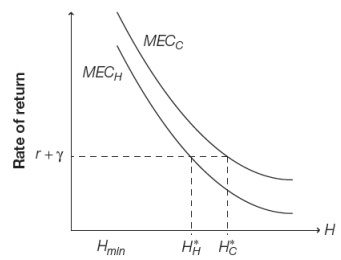Assignment:
A. True/False Explain. Indicate whether each of the following statements is true or false anthen explain why you think this. Include in your explanation any pertinent institutional details and economic reasoning (including appropriate graphs and equations). Please provide concise, clear answers with minimal irrelevant detail. Explanation is required.
1. Suppose you are interested in estimating the elasticity of demand for medical care. A good way to do this would be to compare people who are healthy to people who are sick, and estimate how prices affect the amount of additional care that sick people choose to purchase.
2. In Figure below, an individual with high levels of education has marginal efficiency of investment given by MECC. The marginal efficiency of investment for an individual with low levels of education is given by MECH.

3. In the Grossman model, the optimal choice of health status decreases as people get older.
4. According to the model of rational addiction, if the tax on an addictive good increases, it could lead to an increase the number of non-addicted consumers who try the addictive good.
B. Analytical Problems: Please show all calculations for full credit.
5. Suppose you are collecting data from a country like Japan where the government sets the price of health care. Each prefecture in Japan has a different set of prices. Data from 1999 are displayed in the following table:
Region Outpatient Visits Price per Visit
Tokyo 1 per month 25 Yen
Hokkaido 1.5 per month 10 Yen
a. What is the arc price elasticity of demand for health care in Japan based on these data?
b. Suppose that incomes are generally much higher in Tokyo than in Hokkaido. Is the correct demand function more elastic or more inelastic than your answer to the previous question? Justify your answer.
c. Using your estimated elasticity from part a, what would the demand for health care be if the price in Tokyo were raised to 30 Yen per visit?
d. Using your estimated elasticity from part a, what would the demand in Hokkaido be if the price were lowered to 5 Yen per visit?
6. Washington State decides to introduce a tax on the sale of marijuana. Assume the elasticity of demand is -0.75, and that supply is perfectly elastic.
a) If the tax increases the price of marijuana by 60%, what will happen to the amount that is sold?
b) Suppose marijuana is addictive, and that consumers who choose to buy it are rational addicts. Explain what the theory of rational addition predicts will happen to the quantity sold today if the tax increase begins next year. (Note: the theory of rational addiction says nothing about stockpiling goods to avoid paying taxes, so that is not the answer I am looking for.)
c) Suppose there is a legal market with perfectly elastic supply that pays the tax, and a secondary black market that evades the tax. The elasticity of supply in the black market is 1 (the number doesn't matter, just assume that it's neither perfectly elastic nor perfectly inelastic), and assume that after the tax it's cheaper to buy from the black market at low market quantities.
Draw an example of what the market supply curve would look like. (Hint: the market supply curve represents the lowest price at which you could buy a given quantity of a good.) Now suppose the state is short on money so they raise the tax rate. Show using a supplydemand diagram what will happen to total tax revenue.